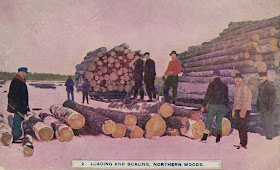During the winter, in addition to the science programs that I present at schools, I also spend a couple of months presenting two different programs on Michigan history. One of these programs focuses on Michigan's logging history.
Logging was one of the first major industries in Michigan and products from Michigan's forests were used to build much of the nation's cities during the period after the American Civil War. For nearly half a century Michigan could lay claim to the title of the logging capital of the world. While other a few other states may dispute this claim, it is hard to argue with a place where one river system alone produced over 22 Billion board feet of lumber during its run!
Recently I purchased a new lot of logging postcards. Most of these are from Michigan, but unfortunately some of the photo locations are not documented on the images.
These postcards show vignettes of logging life. Most images are posed, with little action portrayed in the photograph. One of my favorite images shows a crew of four with a team of horses (used to skid or drag the logs through the woods). Two of the men lean on cant hooks used for rolling logs. A third man leans on a double-bit axe. I especially like the fact that two of the men in the picture have cut off the bottom of their overalls so they don't get soaked with snow.
 |
| A crew of men ready and equipped to move logs through the snowy woods. (Unknown location) |
This next picture is a later image - it dates to probably the 1950s. What I like about this picture is that it shows how teams of oxen (or horses) would be used to skid the logs. A close look at the picture reveals the skidding tongs clamped onto each log. The two sharp points of the tongs would bite into the log so it could be pulled through the snow. Oxen were sometimes used in the camps because of their brute strength, but horse were both faster and required less feed so most camps preferred to use horses.
 |
| Oxen skidding logs (Newaygo County, MI) |
I think this next picture is another later image. The cleared land and fences give the impression that this photo was not taken during the early days of logging in Michigan. I like that this image shows how multiple teams of horses would be connected in tandem to pull a load uphill. When going downhill, a chain was often connected to the back of the sleigh and wrapped around a tree at the top of the hill where a team of horses would be used to help slow the sleigh down.
 |
| Three teams pulling a sleigh uphill (Oceana County, MI) |
I have several pictures in my collection showing crews loading logging sleighs. The men who stacked the logs on the sleighs were known as top loaders. This was one of the most difficult and dangerous jobs in a lumber camp. A good top loader would receive higher pay than many other members of a crew.
One common feature of many logging postcards is lumber camps showing off by loading the biggest sleigh-load of logs imaginable. Sleighs loaded were not loaded like this on a daily basis. Loads of this size are highly impractical. They take too long to load and are really too large of a burden for the horses.
 |
| Loads like this were used to show off - they were not practical. (Wexford County, MI) |
Despite the label on the postcard, this is not a "typical lumber scene". While many lumbering images show full logs that would eventually be cut into boards, another side of logging was the cutting of railroad ties and fence posts. Men who cut posts and ties were often paid by the piece rather than being paid by the day as they were in camps that cut large logs.
 |
| A forgotten part of logging was the cutting of ties and posts (Alpena County, MI) |
I think this is another later image (sometime in the 20th Century). It would have been highly unusual to use a sleigh to haul a single log.
 |
| Hauling a single log on a sleigh (Location unknown) |
The next photograph shows a crew of "river hogs". Also known as "river pigs", these men would float down the river during the spring log drives. Corked boots (boots with spikes on the soles) allowed the to keep their footing as they walked on the floating logs. They used pike poles (the long-handled tools) and peaveys (the short-handled tools) to keep the logs moving downstream.
 |
| River hogs use pike poles and peaveys to control the movement of logs on a river drive (Antrim County, MI) |
By the 1880s, railroads became an important part of logging operations. Trains allowed lumber crews to work far away from rivers. The first image shows a train loaded with logs. At the back of the train is a steam jammer. This steam-powered winch and boom, pivoted on a central axis and allowed crews to lift logs to load them on the train cars.
 |
| Logging trains allowed companies to efficiently log far from rivers (Location unknown) |
In this image, train cars are being loaded by the simpler method of cross-hauling. In this process chain attached to a team of horses (or a powered winch) is used to drag logs up a ramp onto the train where they would be chained in place. If you click on the image, both the chain and team of horses can be seen in the photo.
 |
| Crosshauling logs onto a Grand Trunk rail car at the Coopersville Depot (Ottawa County, MI) |
After World War One, gasoline powered equipment such as this Holt tractor became available for logging. These strong engines could pull long trains consisting of ten or more loaded sleighs across the snow. In this picture, a second tractor with an additional train of sleighs can be seen at the left rear.
 |
| Gasoline tractors greatly reduced the need for horses in logging (Location unknown) |
The piles of logs waiting for sawing at mills are a common feature of many logging photographs. Logs would be stockpiled at the mills after the spring river drives and remain there until thy could be cut up into boards and other products such as shingles, barrel staves, etc..
 |
| Logs at a mill in Alpena. The ship in the middle ground is probably a lumber schooner. (Alpena County, MI) |
 |
| The amount of logs could be truly staggering (Charlevoix County, MI) |
The development of small steam-powered circular saws allowed portable mills to be set up almost anywhere. Boards sawn at these mills would often used locally instead of being shipped for use out of state.
 |
| Portable mills often sawed lumber for local use (Location unknown) |
Information on the back of the next image identifies it as Phipps Mill. It was sent from Henderson, MI and I assume the image was taken near there. I like that you can see the steam engine to the left of the photo and the belt drives that would power the mill. I love seeing how the men are dressed in those old photos - I only wish they were in color.
 |
| Portable mill - note the steam engine and belt drives (Shiawassee County, MI) |
The next picture shows a group of men outside a mill - a circular saw can be seen in the building at the rear. I am going to presume that they are sawing wood to lengths that would later be split into shingles. The wood could also be used to feed the boiler that would provide steam power to the mill. I like this image because it shows a clear picture of a two-man bucking saw. Bucking saws are used to cut logs into lengths. A man to the left rear holds a single-bit axe over his shoulder, and the man to the far right holds the handle of a cant hook (or peavey) for rolling logs.
 |
| A crew processing logs into short lengths probably for shingles (Location unknown) |
The final picture shows an area of land after logging. The stumps, snags, and slash on the ground would do little to hold the sandy soil in place. Later, during the Great Depression, much of this area would be replanted by members of the Civilian Conservation Corps.
 |
| Large areas of the Great Lakes State were completely deforested during the latter half of the 19th Century (Roscommon County, MI) |
For more logging images check out these four posts.
Logging Photos - Getting Logs out of the Woods
More Logging Photographs
Michigan Logging Photos
Days Gone By - Logging Photos



















































